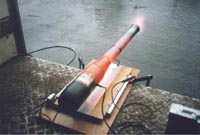|
--------------------
|
|
Beginners' Guide
| First Model | Radio Control | Servos | Batteries | Glow Engines | Turbines | Electrics |
- Pulsejet Engines
Aircraft model builders have always strived to emulate the full-sized aircraft, as
well as their propulsion systems.
The word "pulse" engine may be tracked back to around 1880 - 1890 and it is
claimed that a Frenchman has build a pulsejet engine in the beginning of 1900
however, it's unknown whether he was successful.

|
The Germans used this type of engine
during the W.W.II to power the well-known
V-1 flying bomb.
This power concept was eventually proven
to be relatively inefficient, terribly noisy and
also having a very short lifetime.
|
The valves on the V-1 engine lasted no longer than 30 minutes continuous use.
The pulsejet was therefore abandoned as a full-size aircraft propulsion system.
Nevertheless, it has been used on model aircraft by some enthusiasts until now.

A model pulsjet engine is basically made of a tube consisting of a head with a
venturi shaped air-intake, a diffuser, a combustion chamber, reed valve plates,
a spark plug and an exhaust.

In order to start the engine, a compressed air from an external pump or air bottle
is fed to the angled pipe located near the diffuser while a pulsed high voltage
supply is applied to the sparkplug.
The air/fuel mixture is pushed through the valve into the combustion chamber and
ignited, which causes a noisy explosion that closes the valve plates while the
expanding gasses escape trough the exhaust.
This produces a low pressure inside the combustion chamber that opens the
valves and new air/fuel mixture enters the chamber again, which is ignited by the
residual heat and gasses from the previous explosion.
The high temperature developed keeps the motor running without the spark plug
and the compressed air, which are only needed at the start moment.
Some types have no sparkplug attached. The initial ignition is then obtained by
introducing external sparking wires through the exhaust.
The pipe has an acoustic resonant frequency depending on its length, which must
be close to the valves' working frequency in order to get a reliable operation.

|
The extreme heat developed means that this
engine needs a lot of air cooling and cannot
stand static running on a test-bench for longer
period than about 10 seconds.
It must also be mounted outside the model to
prevent burning damage to the structure.
|
Due to the extreme noise and the high temperature involved, this engine is
absolutely not recommended for beginners and should not be used near
residential areas.

<< Previous Page
 Next Page >>
Next Page >>
|
|